BE440 Brand Management: Building Brand Identity Using Aaker's Model
VerifiedAdded on 2022/09/01
|12
|2782
|18
Essay
AI Summary
This essay critically discusses the key elements a consumer goods company might use to build its brand identity in Singapore, referencing Aaker’s Brand Identity Planning Model. It explores the concept of brand identity, differentiating it from brand image, and emphasizes the importance of a consistent brand identity. Using JBS, a food company, as an example, the essay outlines the steps for creating a recognized brand identity based on Aaker's four perspectives: brand as a product, organization, person, and symbol. It also highlights the significance of value proposition, building credibility, fostering customer relationships, and brand positioning. The essay concludes that a unique brand identity is crucial for commanding price premiums, differentiating the business, and gaining customer loyalty in a competitive market. Desklib offers similar essays and study resources for students.
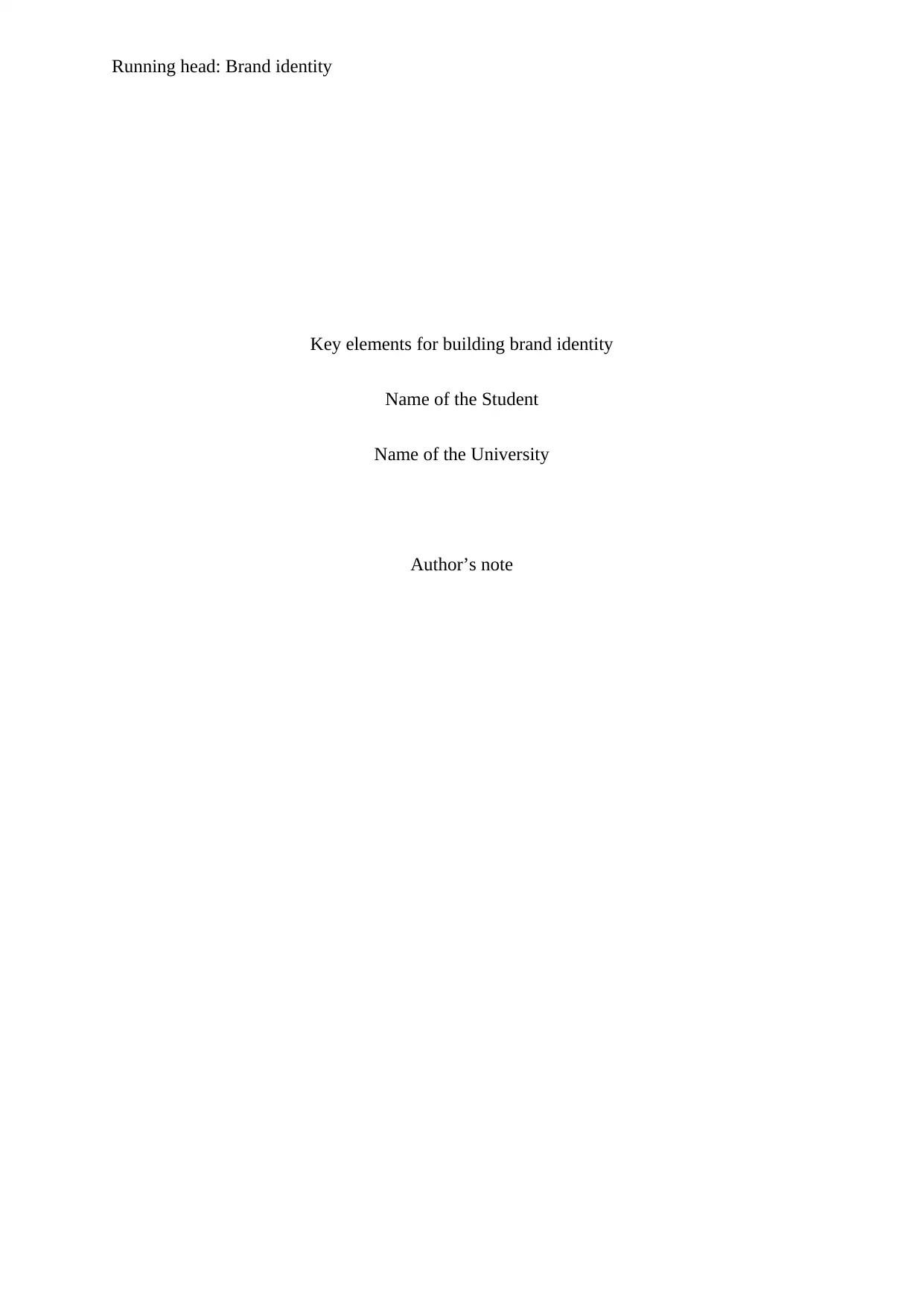
Running head: Brand identity
Key elements for building brand identity
Name of the Student
Name of the University
Author’s note
Key elements for building brand identity
Name of the Student
Name of the University
Author’s note
Paraphrase This Document
Need a fresh take? Get an instant paraphrase of this document with our AI Paraphraser
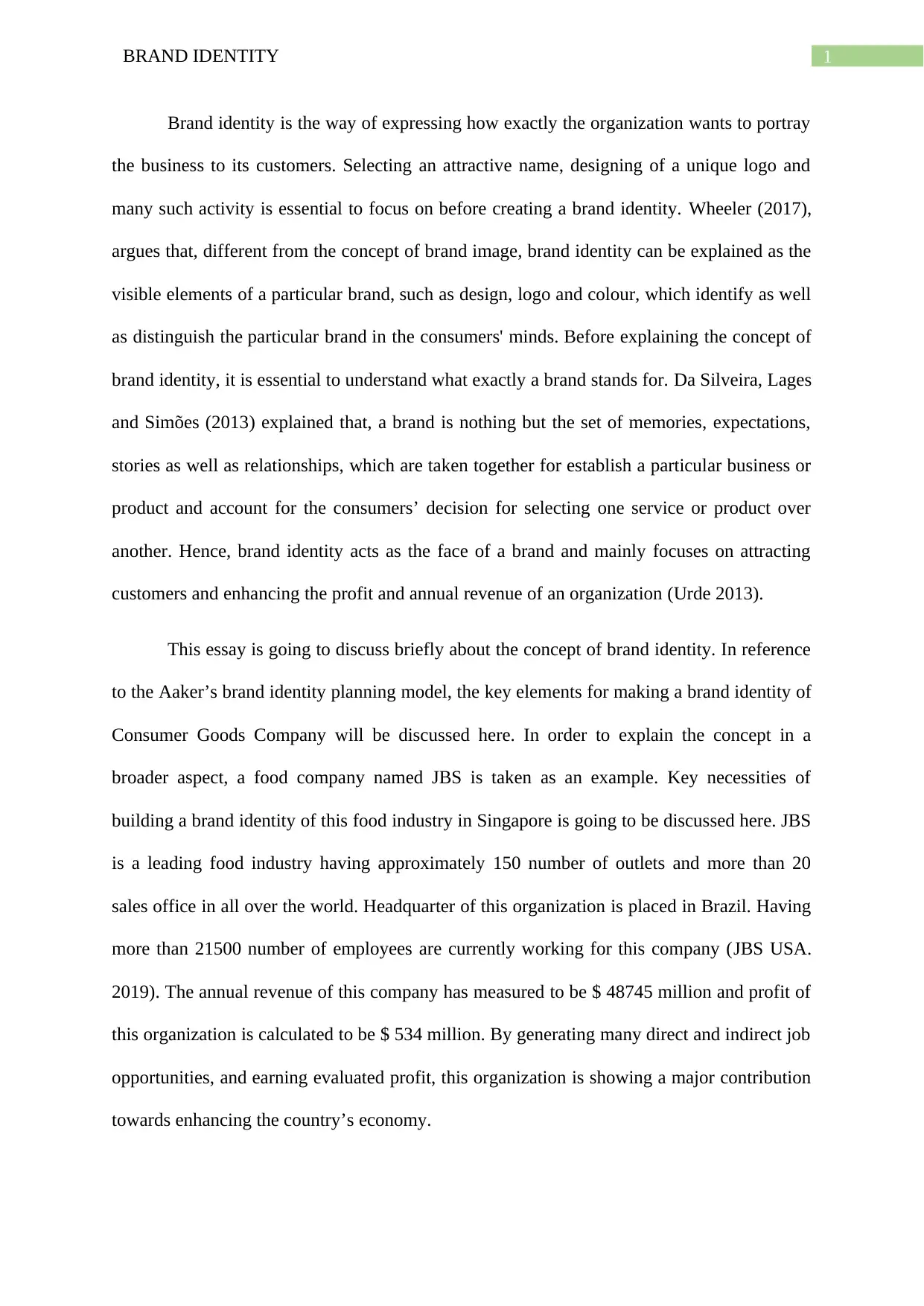
1BRAND IDENTITY
Brand identity is the way of expressing how exactly the organization wants to portray
the business to its customers. Selecting an attractive name, designing of a unique logo and
many such activity is essential to focus on before creating a brand identity. Wheeler (2017),
argues that, different from the concept of brand image, brand identity can be explained as the
visible elements of a particular brand, such as design, logo and colour, which identify as well
as distinguish the particular brand in the consumers' minds. Before explaining the concept of
brand identity, it is essential to understand what exactly a brand stands for. Da Silveira, Lages
and Simões (2013) explained that, a brand is nothing but the set of memories, expectations,
stories as well as relationships, which are taken together for establish a particular business or
product and account for the consumers’ decision for selecting one service or product over
another. Hence, brand identity acts as the face of a brand and mainly focuses on attracting
customers and enhancing the profit and annual revenue of an organization (Urde 2013).
This essay is going to discuss briefly about the concept of brand identity. In reference
to the Aaker’s brand identity planning model, the key elements for making a brand identity of
Consumer Goods Company will be discussed here. In order to explain the concept in a
broader aspect, a food company named JBS is taken as an example. Key necessities of
building a brand identity of this food industry in Singapore is going to be discussed here. JBS
is a leading food industry having approximately 150 number of outlets and more than 20
sales office in all over the world. Headquarter of this organization is placed in Brazil. Having
more than 21500 number of employees are currently working for this company (JBS USA.
2019). The annual revenue of this company has measured to be $ 48745 million and profit of
this organization is calculated to be $ 534 million. By generating many direct and indirect job
opportunities, and earning evaluated profit, this organization is showing a major contribution
towards enhancing the country’s economy.
Brand identity is the way of expressing how exactly the organization wants to portray
the business to its customers. Selecting an attractive name, designing of a unique logo and
many such activity is essential to focus on before creating a brand identity. Wheeler (2017),
argues that, different from the concept of brand image, brand identity can be explained as the
visible elements of a particular brand, such as design, logo and colour, which identify as well
as distinguish the particular brand in the consumers' minds. Before explaining the concept of
brand identity, it is essential to understand what exactly a brand stands for. Da Silveira, Lages
and Simões (2013) explained that, a brand is nothing but the set of memories, expectations,
stories as well as relationships, which are taken together for establish a particular business or
product and account for the consumers’ decision for selecting one service or product over
another. Hence, brand identity acts as the face of a brand and mainly focuses on attracting
customers and enhancing the profit and annual revenue of an organization (Urde 2013).
This essay is going to discuss briefly about the concept of brand identity. In reference
to the Aaker’s brand identity planning model, the key elements for making a brand identity of
Consumer Goods Company will be discussed here. In order to explain the concept in a
broader aspect, a food company named JBS is taken as an example. Key necessities of
building a brand identity of this food industry in Singapore is going to be discussed here. JBS
is a leading food industry having approximately 150 number of outlets and more than 20
sales office in all over the world. Headquarter of this organization is placed in Brazil. Having
more than 21500 number of employees are currently working for this company (JBS USA.
2019). The annual revenue of this company has measured to be $ 48745 million and profit of
this organization is calculated to be $ 534 million. By generating many direct and indirect job
opportunities, and earning evaluated profit, this organization is showing a major contribution
towards enhancing the country’s economy.
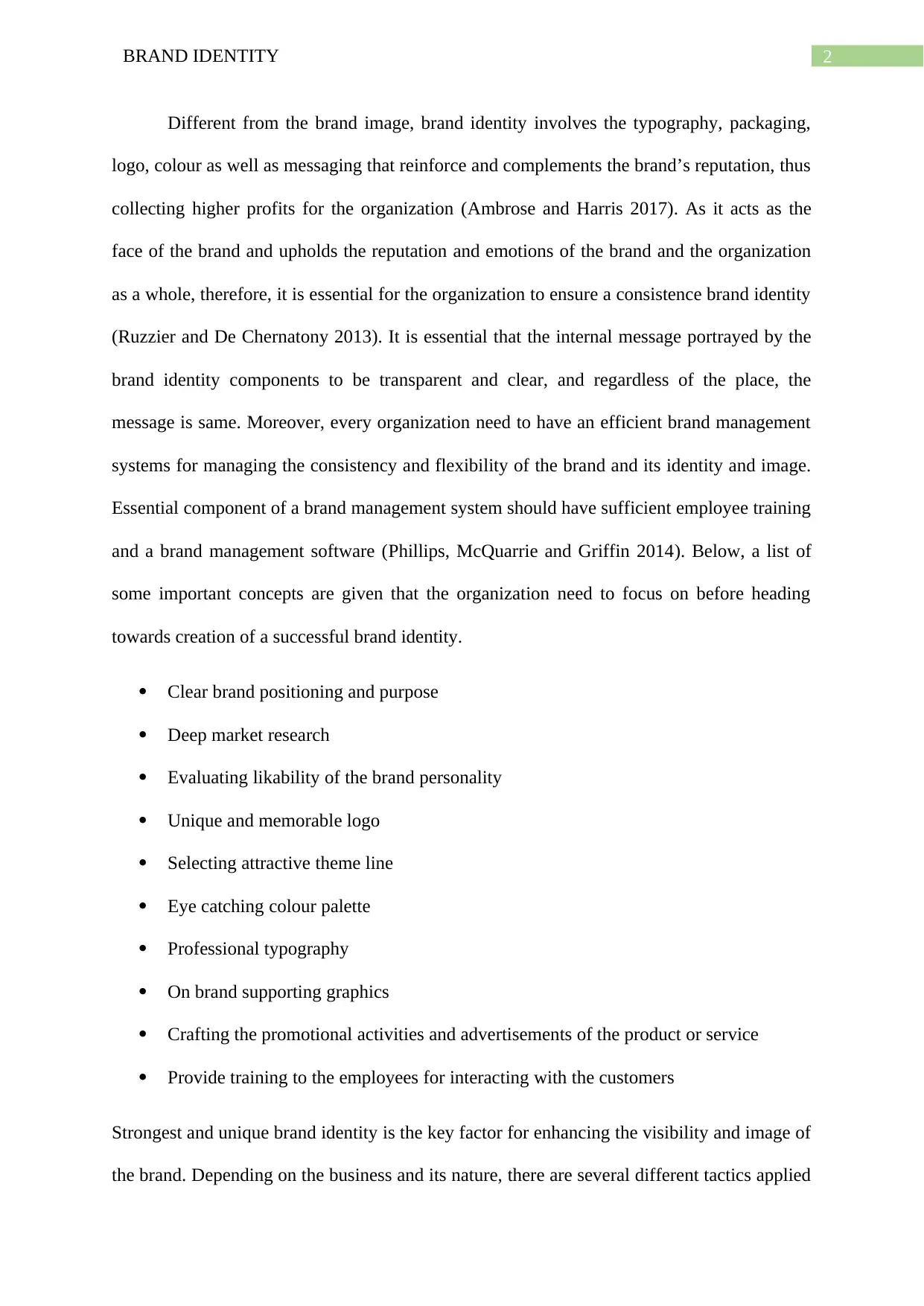
2BRAND IDENTITY
Different from the brand image, brand identity involves the typography, packaging,
logo, colour as well as messaging that reinforce and complements the brand’s reputation, thus
collecting higher profits for the organization (Ambrose and Harris 2017). As it acts as the
face of the brand and upholds the reputation and emotions of the brand and the organization
as a whole, therefore, it is essential for the organization to ensure a consistence brand identity
(Ruzzier and De Chernatony 2013). It is essential that the internal message portrayed by the
brand identity components to be transparent and clear, and regardless of the place, the
message is same. Moreover, every organization need to have an efficient brand management
systems for managing the consistency and flexibility of the brand and its identity and image.
Essential component of a brand management system should have sufficient employee training
and a brand management software (Phillips, McQuarrie and Griffin 2014). Below, a list of
some important concepts are given that the organization need to focus on before heading
towards creation of a successful brand identity.
Clear brand positioning and purpose
Deep market research
Evaluating likability of the brand personality
Unique and memorable logo
Selecting attractive theme line
Eye catching colour palette
Professional typography
On brand supporting graphics
Crafting the promotional activities and advertisements of the product or service
Provide training to the employees for interacting with the customers
Strongest and unique brand identity is the key factor for enhancing the visibility and image of
the brand. Depending on the business and its nature, there are several different tactics applied
Different from the brand image, brand identity involves the typography, packaging,
logo, colour as well as messaging that reinforce and complements the brand’s reputation, thus
collecting higher profits for the organization (Ambrose and Harris 2017). As it acts as the
face of the brand and upholds the reputation and emotions of the brand and the organization
as a whole, therefore, it is essential for the organization to ensure a consistence brand identity
(Ruzzier and De Chernatony 2013). It is essential that the internal message portrayed by the
brand identity components to be transparent and clear, and regardless of the place, the
message is same. Moreover, every organization need to have an efficient brand management
systems for managing the consistency and flexibility of the brand and its identity and image.
Essential component of a brand management system should have sufficient employee training
and a brand management software (Phillips, McQuarrie and Griffin 2014). Below, a list of
some important concepts are given that the organization need to focus on before heading
towards creation of a successful brand identity.
Clear brand positioning and purpose
Deep market research
Evaluating likability of the brand personality
Unique and memorable logo
Selecting attractive theme line
Eye catching colour palette
Professional typography
On brand supporting graphics
Crafting the promotional activities and advertisements of the product or service
Provide training to the employees for interacting with the customers
Strongest and unique brand identity is the key factor for enhancing the visibility and image of
the brand. Depending on the business and its nature, there are several different tactics applied
⊘ This is a preview!⊘
Do you want full access?
Subscribe today to unlock all pages.

Trusted by 1+ million students worldwide
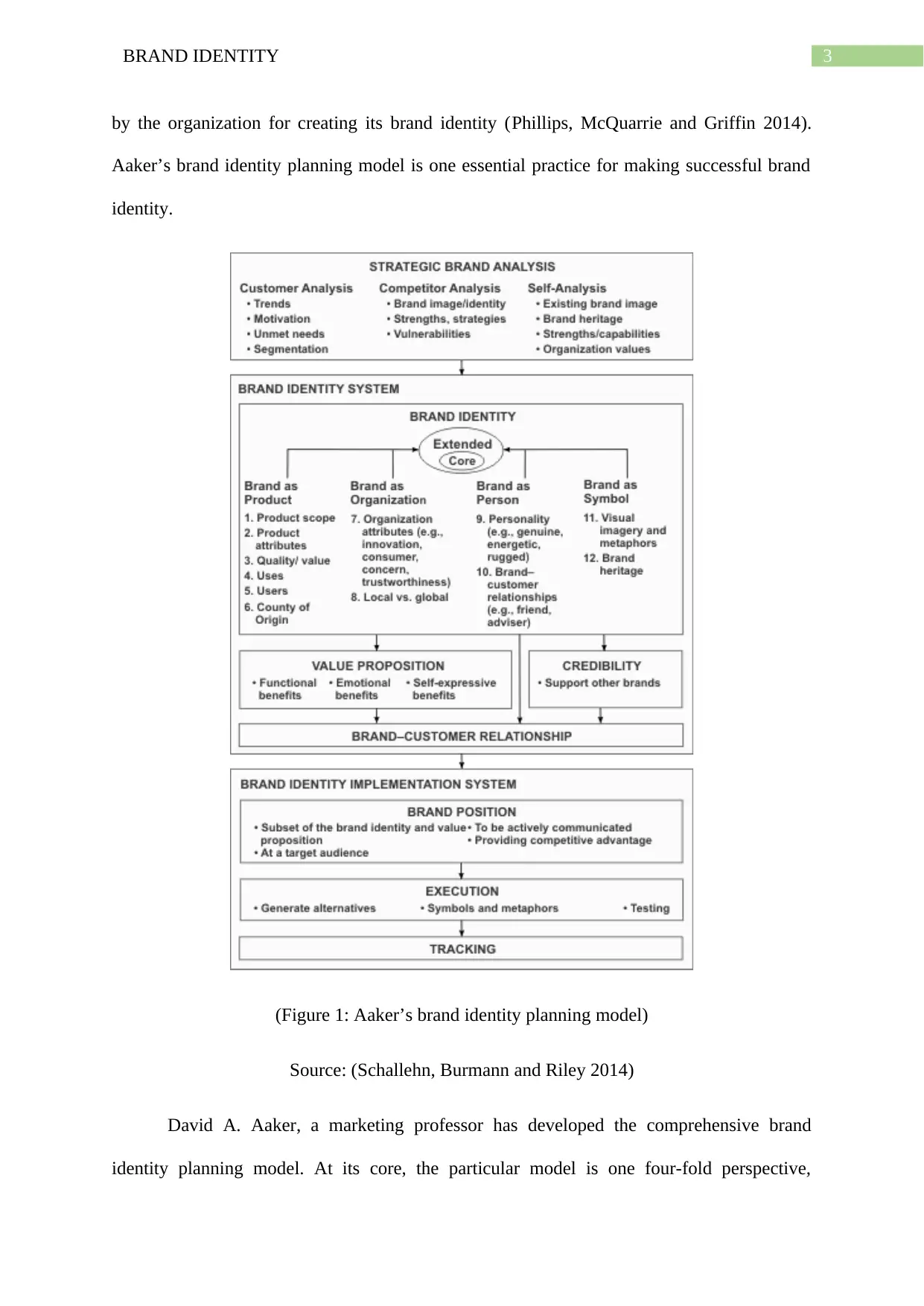
3BRAND IDENTITY
by the organization for creating its brand identity (Phillips, McQuarrie and Griffin 2014).
Aaker’s brand identity planning model is one essential practice for making successful brand
identity.
(Figure 1: Aaker’s brand identity planning model)
Source: (Schallehn, Burmann and Riley 2014)
David A. Aaker, a marketing professor has developed the comprehensive brand
identity planning model. At its core, the particular model is one four-fold perspective,
by the organization for creating its brand identity (Phillips, McQuarrie and Griffin 2014).
Aaker’s brand identity planning model is one essential practice for making successful brand
identity.
(Figure 1: Aaker’s brand identity planning model)
Source: (Schallehn, Burmann and Riley 2014)
David A. Aaker, a marketing professor has developed the comprehensive brand
identity planning model. At its core, the particular model is one four-fold perspective,
Paraphrase This Document
Need a fresh take? Get an instant paraphrase of this document with our AI Paraphraser
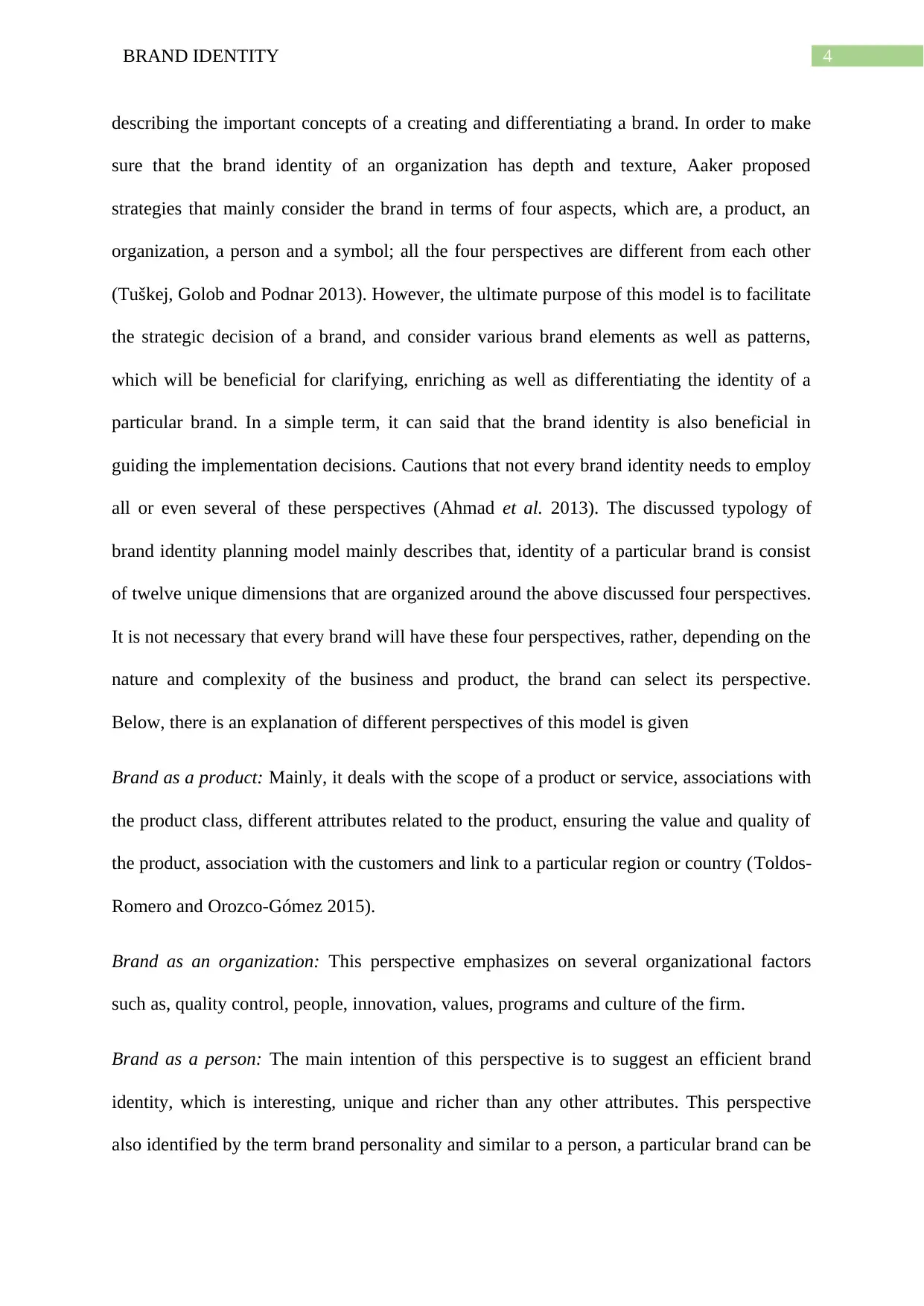
4BRAND IDENTITY
describing the important concepts of a creating and differentiating a brand. In order to make
sure that the brand identity of an organization has depth and texture, Aaker proposed
strategies that mainly consider the brand in terms of four aspects, which are, a product, an
organization, a person and a symbol; all the four perspectives are different from each other
(Tuškej, Golob and Podnar 2013). However, the ultimate purpose of this model is to facilitate
the strategic decision of a brand, and consider various brand elements as well as patterns,
which will be beneficial for clarifying, enriching as well as differentiating the identity of a
particular brand. In a simple term, it can said that the brand identity is also beneficial in
guiding the implementation decisions. Cautions that not every brand identity needs to employ
all or even several of these perspectives (Ahmad et al. 2013). The discussed typology of
brand identity planning model mainly describes that, identity of a particular brand is consist
of twelve unique dimensions that are organized around the above discussed four perspectives.
It is not necessary that every brand will have these four perspectives, rather, depending on the
nature and complexity of the business and product, the brand can select its perspective.
Below, there is an explanation of different perspectives of this model is given
Brand as a product: Mainly, it deals with the scope of a product or service, associations with
the product class, different attributes related to the product, ensuring the value and quality of
the product, association with the customers and link to a particular region or country (Toldos-
Romero and Orozco-Gómez 2015).
Brand as an organization: This perspective emphasizes on several organizational factors
such as, quality control, people, innovation, values, programs and culture of the firm.
Brand as a person: The main intention of this perspective is to suggest an efficient brand
identity, which is interesting, unique and richer than any other attributes. This perspective
also identified by the term brand personality and similar to a person, a particular brand can be
describing the important concepts of a creating and differentiating a brand. In order to make
sure that the brand identity of an organization has depth and texture, Aaker proposed
strategies that mainly consider the brand in terms of four aspects, which are, a product, an
organization, a person and a symbol; all the four perspectives are different from each other
(Tuškej, Golob and Podnar 2013). However, the ultimate purpose of this model is to facilitate
the strategic decision of a brand, and consider various brand elements as well as patterns,
which will be beneficial for clarifying, enriching as well as differentiating the identity of a
particular brand. In a simple term, it can said that the brand identity is also beneficial in
guiding the implementation decisions. Cautions that not every brand identity needs to employ
all or even several of these perspectives (Ahmad et al. 2013). The discussed typology of
brand identity planning model mainly describes that, identity of a particular brand is consist
of twelve unique dimensions that are organized around the above discussed four perspectives.
It is not necessary that every brand will have these four perspectives, rather, depending on the
nature and complexity of the business and product, the brand can select its perspective.
Below, there is an explanation of different perspectives of this model is given
Brand as a product: Mainly, it deals with the scope of a product or service, associations with
the product class, different attributes related to the product, ensuring the value and quality of
the product, association with the customers and link to a particular region or country (Toldos-
Romero and Orozco-Gómez 2015).
Brand as an organization: This perspective emphasizes on several organizational factors
such as, quality control, people, innovation, values, programs and culture of the firm.
Brand as a person: The main intention of this perspective is to suggest an efficient brand
identity, which is interesting, unique and richer than any other attributes. This perspective
also identified by the term brand personality and similar to a person, a particular brand can be
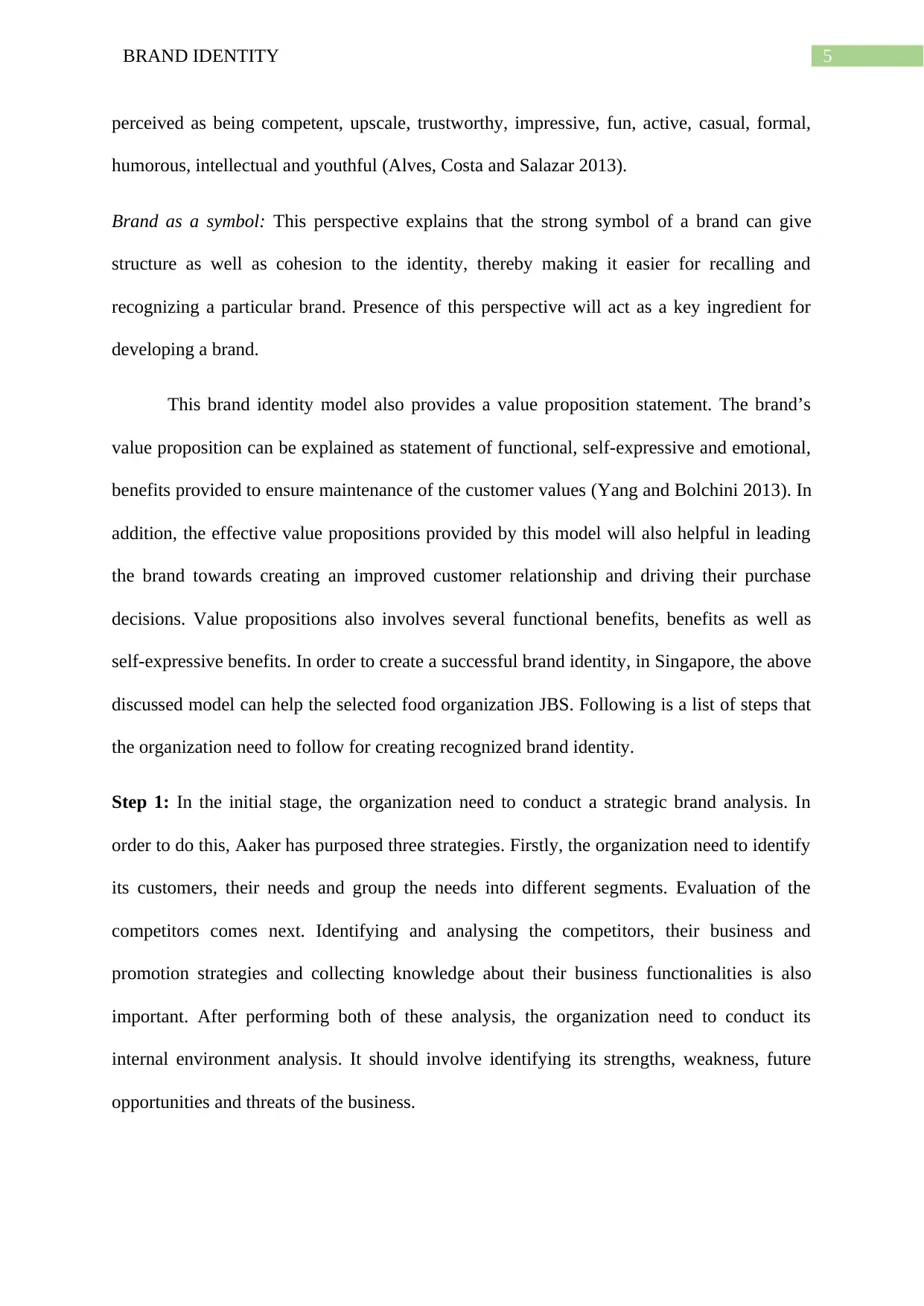
5BRAND IDENTITY
perceived as being competent, upscale, trustworthy, impressive, fun, active, casual, formal,
humorous, intellectual and youthful (Alves, Costa and Salazar 2013).
Brand as a symbol: This perspective explains that the strong symbol of a brand can give
structure as well as cohesion to the identity, thereby making it easier for recalling and
recognizing a particular brand. Presence of this perspective will act as a key ingredient for
developing a brand.
This brand identity model also provides a value proposition statement. The brand’s
value proposition can be explained as statement of functional, self-expressive and emotional,
benefits provided to ensure maintenance of the customer values (Yang and Bolchini 2013). In
addition, the effective value propositions provided by this model will also helpful in leading
the brand towards creating an improved customer relationship and driving their purchase
decisions. Value propositions also involves several functional benefits, benefits as well as
self-expressive benefits. In order to create a successful brand identity, in Singapore, the above
discussed model can help the selected food organization JBS. Following is a list of steps that
the organization need to follow for creating recognized brand identity.
Step 1: In the initial stage, the organization need to conduct a strategic brand analysis. In
order to do this, Aaker has purposed three strategies. Firstly, the organization need to identify
its customers, their needs and group the needs into different segments. Evaluation of the
competitors comes next. Identifying and analysing the competitors, their business and
promotion strategies and collecting knowledge about their business functionalities is also
important. After performing both of these analysis, the organization need to conduct its
internal environment analysis. It should involve identifying its strengths, weakness, future
opportunities and threats of the business.
perceived as being competent, upscale, trustworthy, impressive, fun, active, casual, formal,
humorous, intellectual and youthful (Alves, Costa and Salazar 2013).
Brand as a symbol: This perspective explains that the strong symbol of a brand can give
structure as well as cohesion to the identity, thereby making it easier for recalling and
recognizing a particular brand. Presence of this perspective will act as a key ingredient for
developing a brand.
This brand identity model also provides a value proposition statement. The brand’s
value proposition can be explained as statement of functional, self-expressive and emotional,
benefits provided to ensure maintenance of the customer values (Yang and Bolchini 2013). In
addition, the effective value propositions provided by this model will also helpful in leading
the brand towards creating an improved customer relationship and driving their purchase
decisions. Value propositions also involves several functional benefits, benefits as well as
self-expressive benefits. In order to create a successful brand identity, in Singapore, the above
discussed model can help the selected food organization JBS. Following is a list of steps that
the organization need to follow for creating recognized brand identity.
Step 1: In the initial stage, the organization need to conduct a strategic brand analysis. In
order to do this, Aaker has purposed three strategies. Firstly, the organization need to identify
its customers, their needs and group the needs into different segments. Evaluation of the
competitors comes next. Identifying and analysing the competitors, their business and
promotion strategies and collecting knowledge about their business functionalities is also
important. After performing both of these analysis, the organization need to conduct its
internal environment analysis. It should involve identifying its strengths, weakness, future
opportunities and threats of the business.
⊘ This is a preview!⊘
Do you want full access?
Subscribe today to unlock all pages.

Trusted by 1+ million students worldwide
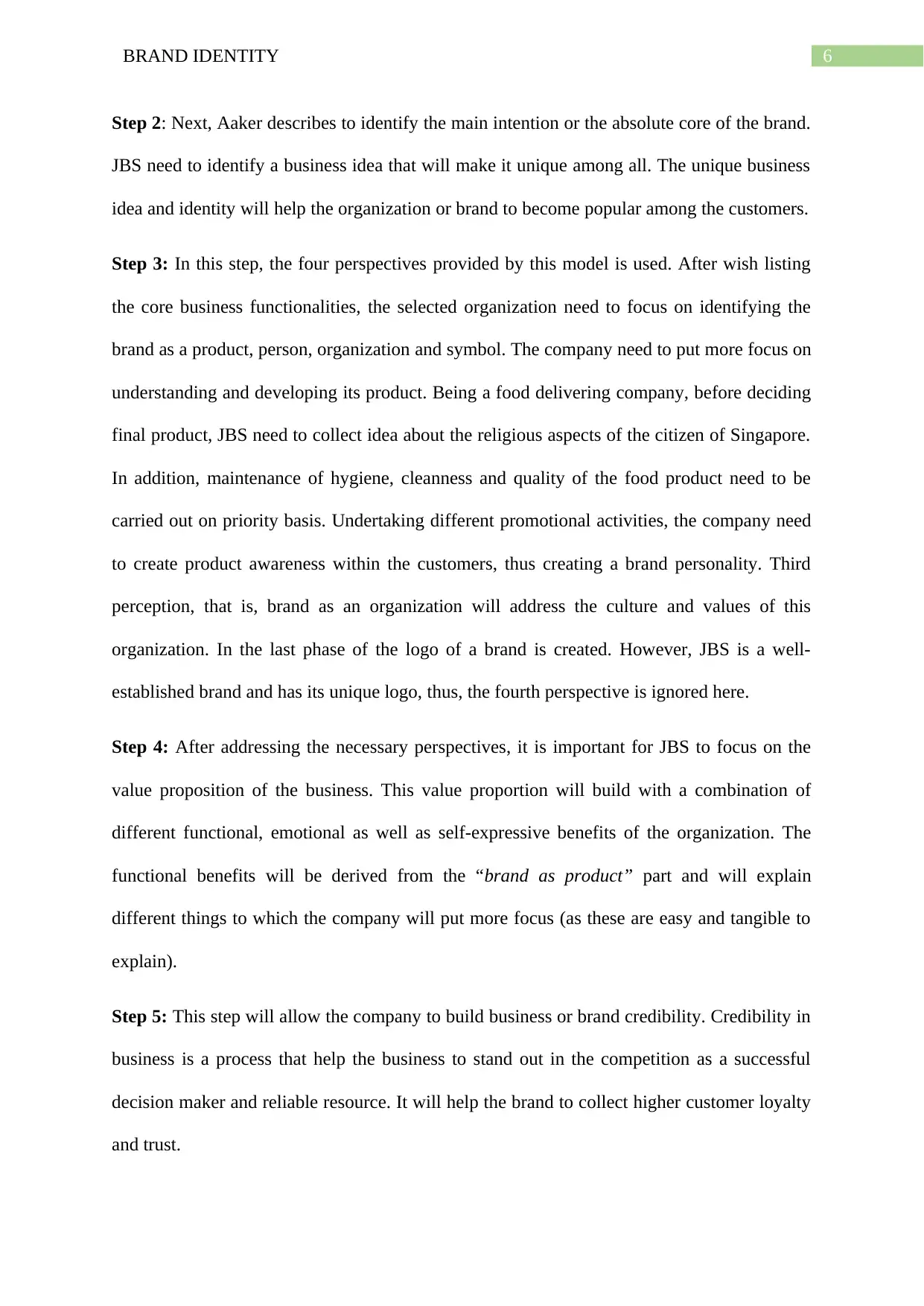
6BRAND IDENTITY
Step 2: Next, Aaker describes to identify the main intention or the absolute core of the brand.
JBS need to identify a business idea that will make it unique among all. The unique business
idea and identity will help the organization or brand to become popular among the customers.
Step 3: In this step, the four perspectives provided by this model is used. After wish listing
the core business functionalities, the selected organization need to focus on identifying the
brand as a product, person, organization and symbol. The company need to put more focus on
understanding and developing its product. Being a food delivering company, before deciding
final product, JBS need to collect idea about the religious aspects of the citizen of Singapore.
In addition, maintenance of hygiene, cleanness and quality of the food product need to be
carried out on priority basis. Undertaking different promotional activities, the company need
to create product awareness within the customers, thus creating a brand personality. Third
perception, that is, brand as an organization will address the culture and values of this
organization. In the last phase of the logo of a brand is created. However, JBS is a well-
established brand and has its unique logo, thus, the fourth perspective is ignored here.
Step 4: After addressing the necessary perspectives, it is important for JBS to focus on the
value proposition of the business. This value proportion will build with a combination of
different functional, emotional as well as self-expressive benefits of the organization. The
functional benefits will be derived from the “brand as product” part and will explain
different things to which the company will put more focus (as these are easy and tangible to
explain).
Step 5: This step will allow the company to build business or brand credibility. Credibility in
business is a process that help the business to stand out in the competition as a successful
decision maker and reliable resource. It will help the brand to collect higher customer loyalty
and trust.
Step 2: Next, Aaker describes to identify the main intention or the absolute core of the brand.
JBS need to identify a business idea that will make it unique among all. The unique business
idea and identity will help the organization or brand to become popular among the customers.
Step 3: In this step, the four perspectives provided by this model is used. After wish listing
the core business functionalities, the selected organization need to focus on identifying the
brand as a product, person, organization and symbol. The company need to put more focus on
understanding and developing its product. Being a food delivering company, before deciding
final product, JBS need to collect idea about the religious aspects of the citizen of Singapore.
In addition, maintenance of hygiene, cleanness and quality of the food product need to be
carried out on priority basis. Undertaking different promotional activities, the company need
to create product awareness within the customers, thus creating a brand personality. Third
perception, that is, brand as an organization will address the culture and values of this
organization. In the last phase of the logo of a brand is created. However, JBS is a well-
established brand and has its unique logo, thus, the fourth perspective is ignored here.
Step 4: After addressing the necessary perspectives, it is important for JBS to focus on the
value proposition of the business. This value proportion will build with a combination of
different functional, emotional as well as self-expressive benefits of the organization. The
functional benefits will be derived from the “brand as product” part and will explain
different things to which the company will put more focus (as these are easy and tangible to
explain).
Step 5: This step will allow the company to build business or brand credibility. Credibility in
business is a process that help the business to stand out in the competition as a successful
decision maker and reliable resource. It will help the brand to collect higher customer loyalty
and trust.
Paraphrase This Document
Need a fresh take? Get an instant paraphrase of this document with our AI Paraphraser
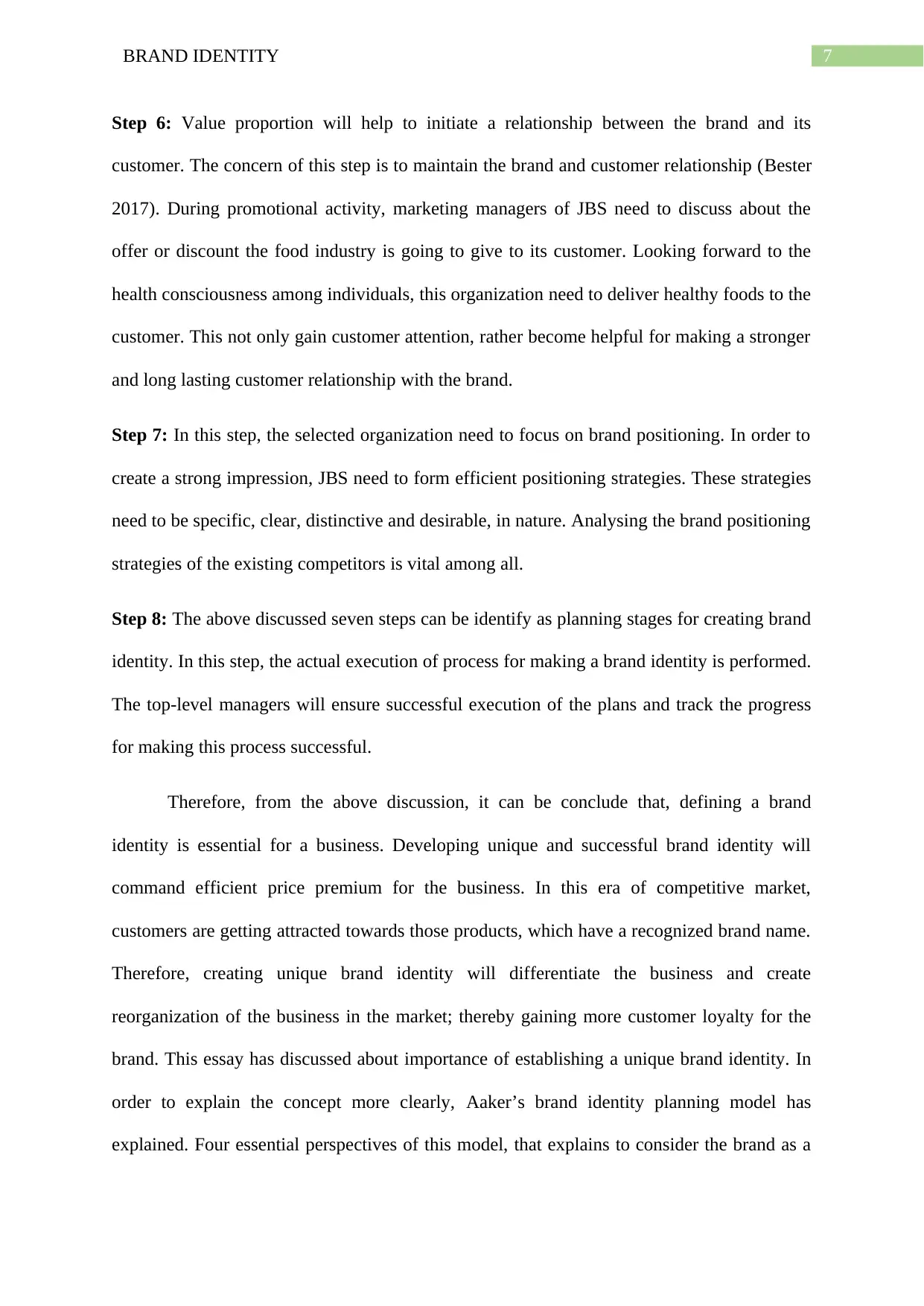
7BRAND IDENTITY
Step 6: Value proportion will help to initiate a relationship between the brand and its
customer. The concern of this step is to maintain the brand and customer relationship (Bester
2017). During promotional activity, marketing managers of JBS need to discuss about the
offer or discount the food industry is going to give to its customer. Looking forward to the
health consciousness among individuals, this organization need to deliver healthy foods to the
customer. This not only gain customer attention, rather become helpful for making a stronger
and long lasting customer relationship with the brand.
Step 7: In this step, the selected organization need to focus on brand positioning. In order to
create a strong impression, JBS need to form efficient positioning strategies. These strategies
need to be specific, clear, distinctive and desirable, in nature. Analysing the brand positioning
strategies of the existing competitors is vital among all.
Step 8: The above discussed seven steps can be identify as planning stages for creating brand
identity. In this step, the actual execution of process for making a brand identity is performed.
The top-level managers will ensure successful execution of the plans and track the progress
for making this process successful.
Therefore, from the above discussion, it can be conclude that, defining a brand
identity is essential for a business. Developing unique and successful brand identity will
command efficient price premium for the business. In this era of competitive market,
customers are getting attracted towards those products, which have a recognized brand name.
Therefore, creating unique brand identity will differentiate the business and create
reorganization of the business in the market; thereby gaining more customer loyalty for the
brand. This essay has discussed about importance of establishing a unique brand identity. In
order to explain the concept more clearly, Aaker’s brand identity planning model has
explained. Four essential perspectives of this model, that explains to consider the brand as a
Step 6: Value proportion will help to initiate a relationship between the brand and its
customer. The concern of this step is to maintain the brand and customer relationship (Bester
2017). During promotional activity, marketing managers of JBS need to discuss about the
offer or discount the food industry is going to give to its customer. Looking forward to the
health consciousness among individuals, this organization need to deliver healthy foods to the
customer. This not only gain customer attention, rather become helpful for making a stronger
and long lasting customer relationship with the brand.
Step 7: In this step, the selected organization need to focus on brand positioning. In order to
create a strong impression, JBS need to form efficient positioning strategies. These strategies
need to be specific, clear, distinctive and desirable, in nature. Analysing the brand positioning
strategies of the existing competitors is vital among all.
Step 8: The above discussed seven steps can be identify as planning stages for creating brand
identity. In this step, the actual execution of process for making a brand identity is performed.
The top-level managers will ensure successful execution of the plans and track the progress
for making this process successful.
Therefore, from the above discussion, it can be conclude that, defining a brand
identity is essential for a business. Developing unique and successful brand identity will
command efficient price premium for the business. In this era of competitive market,
customers are getting attracted towards those products, which have a recognized brand name.
Therefore, creating unique brand identity will differentiate the business and create
reorganization of the business in the market; thereby gaining more customer loyalty for the
brand. This essay has discussed about importance of establishing a unique brand identity. In
order to explain the concept more clearly, Aaker’s brand identity planning model has
explained. Four essential perspectives of this model, that explains to consider the brand as a
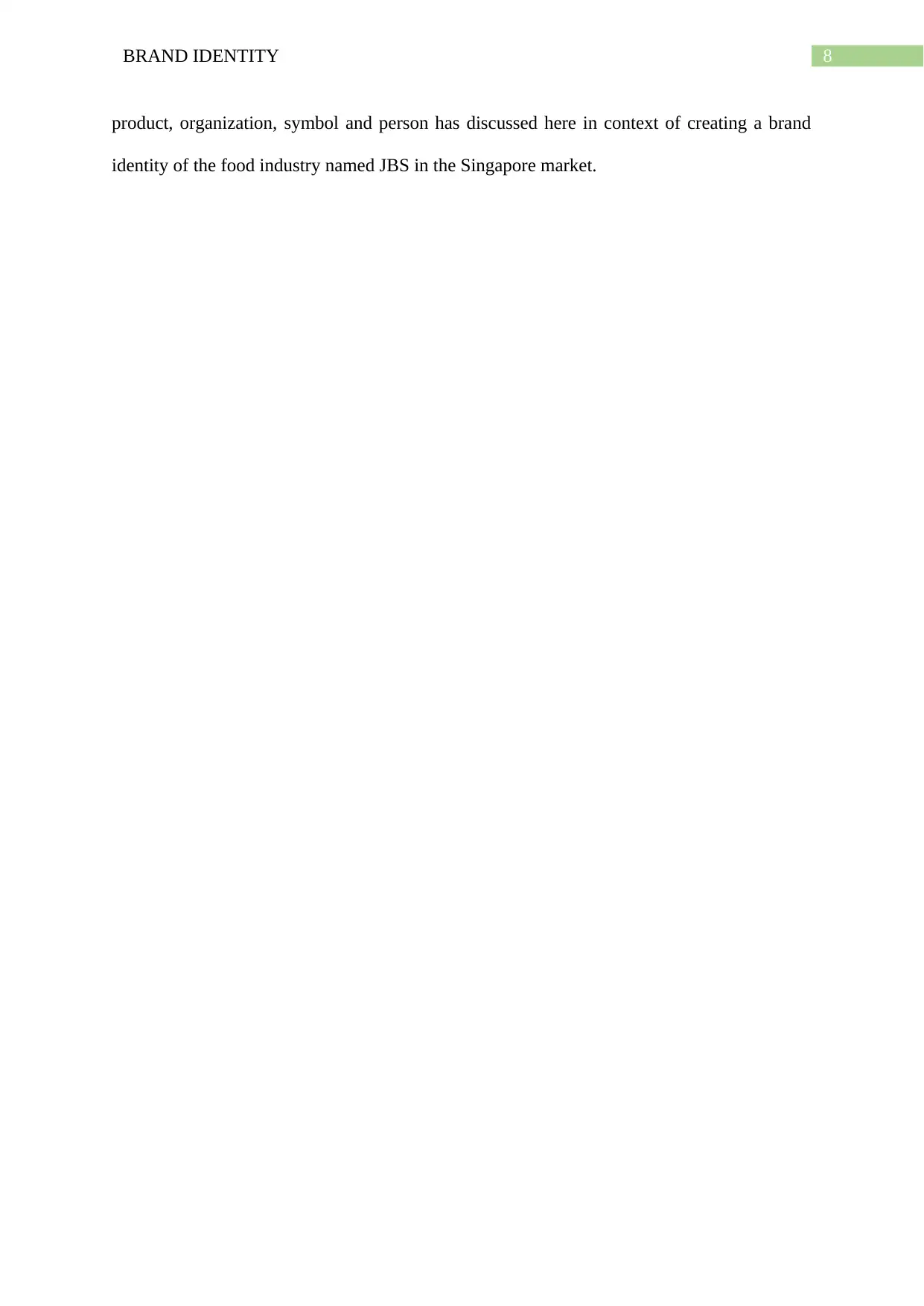
8BRAND IDENTITY
product, organization, symbol and person has discussed here in context of creating a brand
identity of the food industry named JBS in the Singapore market.
product, organization, symbol and person has discussed here in context of creating a brand
identity of the food industry named JBS in the Singapore market.
⊘ This is a preview!⊘
Do you want full access?
Subscribe today to unlock all pages.

Trusted by 1+ million students worldwide
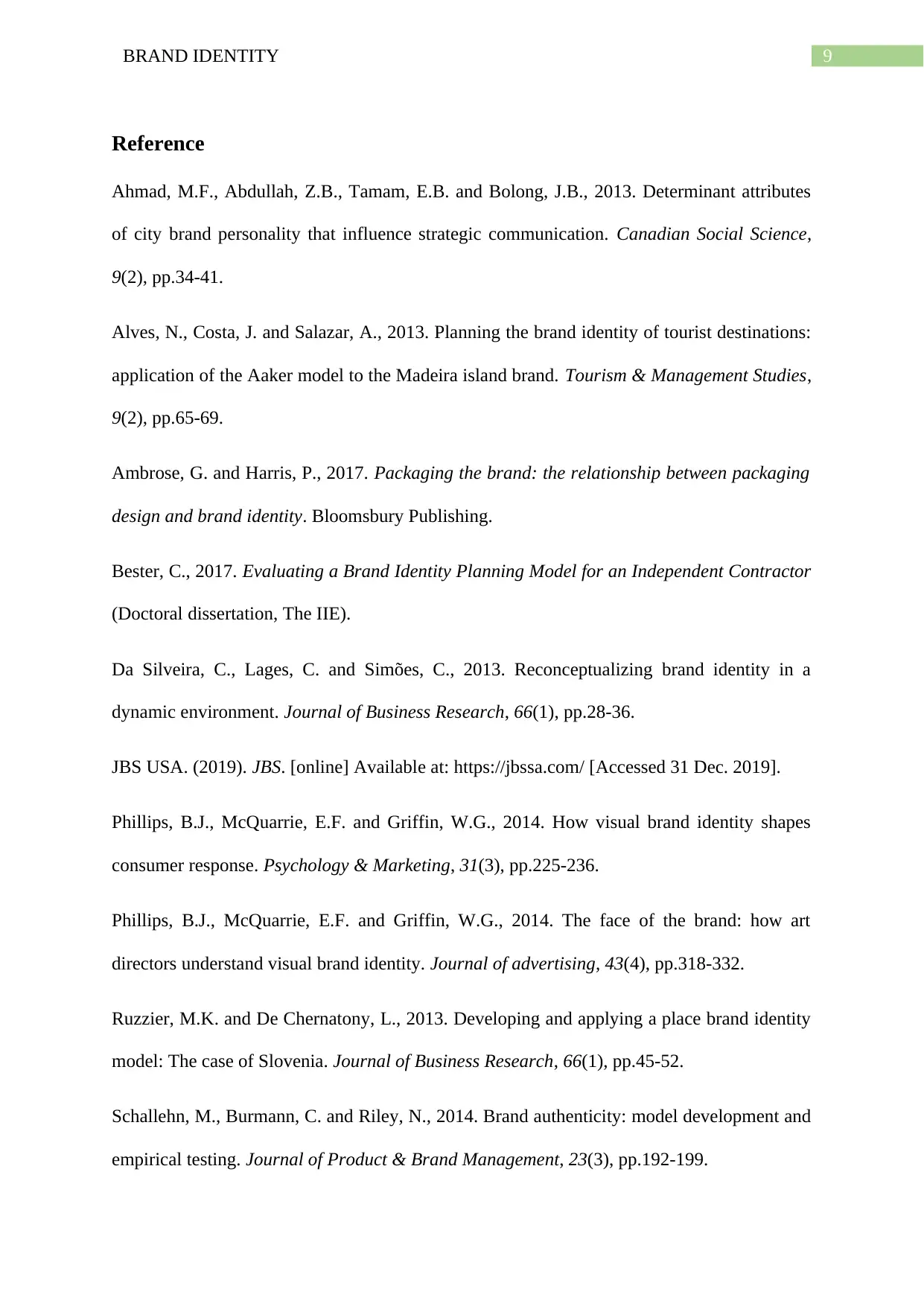
9BRAND IDENTITY
Reference
Ahmad, M.F., Abdullah, Z.B., Tamam, E.B. and Bolong, J.B., 2013. Determinant attributes
of city brand personality that influence strategic communication. Canadian Social Science,
9(2), pp.34-41.
Alves, N., Costa, J. and Salazar, A., 2013. Planning the brand identity of tourist destinations:
application of the Aaker model to the Madeira island brand. Tourism & Management Studies,
9(2), pp.65-69.
Ambrose, G. and Harris, P., 2017. Packaging the brand: the relationship between packaging
design and brand identity. Bloomsbury Publishing.
Bester, C., 2017. Evaluating a Brand Identity Planning Model for an Independent Contractor
(Doctoral dissertation, The IIE).
Da Silveira, C., Lages, C. and Simões, C., 2013. Reconceptualizing brand identity in a
dynamic environment. Journal of Business Research, 66(1), pp.28-36.
JBS USA. (2019). JBS. [online] Available at: https://jbssa.com/ [Accessed 31 Dec. 2019].
Phillips, B.J., McQuarrie, E.F. and Griffin, W.G., 2014. How visual brand identity shapes
consumer response. Psychology & Marketing, 31(3), pp.225-236.
Phillips, B.J., McQuarrie, E.F. and Griffin, W.G., 2014. The face of the brand: how art
directors understand visual brand identity. Journal of advertising, 43(4), pp.318-332.
Ruzzier, M.K. and De Chernatony, L., 2013. Developing and applying a place brand identity
model: The case of Slovenia. Journal of Business Research, 66(1), pp.45-52.
Schallehn, M., Burmann, C. and Riley, N., 2014. Brand authenticity: model development and
empirical testing. Journal of Product & Brand Management, 23(3), pp.192-199.
Reference
Ahmad, M.F., Abdullah, Z.B., Tamam, E.B. and Bolong, J.B., 2013. Determinant attributes
of city brand personality that influence strategic communication. Canadian Social Science,
9(2), pp.34-41.
Alves, N., Costa, J. and Salazar, A., 2013. Planning the brand identity of tourist destinations:
application of the Aaker model to the Madeira island brand. Tourism & Management Studies,
9(2), pp.65-69.
Ambrose, G. and Harris, P., 2017. Packaging the brand: the relationship between packaging
design and brand identity. Bloomsbury Publishing.
Bester, C., 2017. Evaluating a Brand Identity Planning Model for an Independent Contractor
(Doctoral dissertation, The IIE).
Da Silveira, C., Lages, C. and Simões, C., 2013. Reconceptualizing brand identity in a
dynamic environment. Journal of Business Research, 66(1), pp.28-36.
JBS USA. (2019). JBS. [online] Available at: https://jbssa.com/ [Accessed 31 Dec. 2019].
Phillips, B.J., McQuarrie, E.F. and Griffin, W.G., 2014. How visual brand identity shapes
consumer response. Psychology & Marketing, 31(3), pp.225-236.
Phillips, B.J., McQuarrie, E.F. and Griffin, W.G., 2014. The face of the brand: how art
directors understand visual brand identity. Journal of advertising, 43(4), pp.318-332.
Ruzzier, M.K. and De Chernatony, L., 2013. Developing and applying a place brand identity
model: The case of Slovenia. Journal of Business Research, 66(1), pp.45-52.
Schallehn, M., Burmann, C. and Riley, N., 2014. Brand authenticity: model development and
empirical testing. Journal of Product & Brand Management, 23(3), pp.192-199.
Paraphrase This Document
Need a fresh take? Get an instant paraphrase of this document with our AI Paraphraser
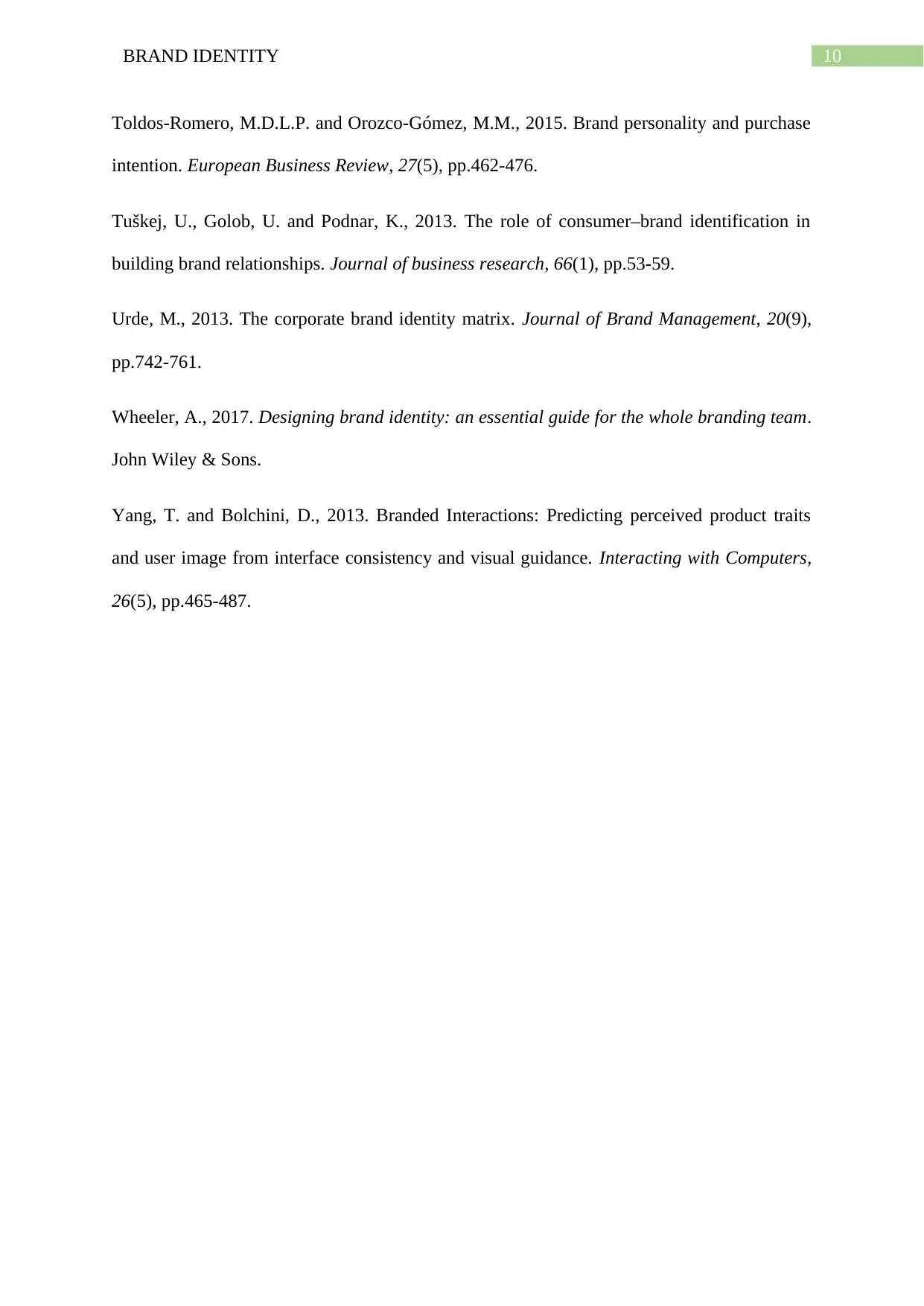
10BRAND IDENTITY
Toldos-Romero, M.D.L.P. and Orozco-Gómez, M.M., 2015. Brand personality and purchase
intention. European Business Review, 27(5), pp.462-476.
Tuškej, U., Golob, U. and Podnar, K., 2013. The role of consumer–brand identification in
building brand relationships. Journal of business research, 66(1), pp.53-59.
Urde, M., 2013. The corporate brand identity matrix. Journal of Brand Management, 20(9),
pp.742-761.
Wheeler, A., 2017. Designing brand identity: an essential guide for the whole branding team.
John Wiley & Sons.
Yang, T. and Bolchini, D., 2013. Branded Interactions: Predicting perceived product traits
and user image from interface consistency and visual guidance. Interacting with Computers,
26(5), pp.465-487.
Toldos-Romero, M.D.L.P. and Orozco-Gómez, M.M., 2015. Brand personality and purchase
intention. European Business Review, 27(5), pp.462-476.
Tuškej, U., Golob, U. and Podnar, K., 2013. The role of consumer–brand identification in
building brand relationships. Journal of business research, 66(1), pp.53-59.
Urde, M., 2013. The corporate brand identity matrix. Journal of Brand Management, 20(9),
pp.742-761.
Wheeler, A., 2017. Designing brand identity: an essential guide for the whole branding team.
John Wiley & Sons.
Yang, T. and Bolchini, D., 2013. Branded Interactions: Predicting perceived product traits
and user image from interface consistency and visual guidance. Interacting with Computers,
26(5), pp.465-487.

11BRAND IDENTITY
⊘ This is a preview!⊘
Do you want full access?
Subscribe today to unlock all pages.

Trusted by 1+ million students worldwide
1 out of 12
Related Documents
Your All-in-One AI-Powered Toolkit for Academic Success.
+13062052269
info@desklib.com
Available 24*7 on WhatsApp / Email
![[object Object]](/_next/static/media/star-bottom.7253800d.svg)
Unlock your academic potential
Copyright © 2020–2025 A2Z Services. All Rights Reserved. Developed and managed by ZUCOL.





